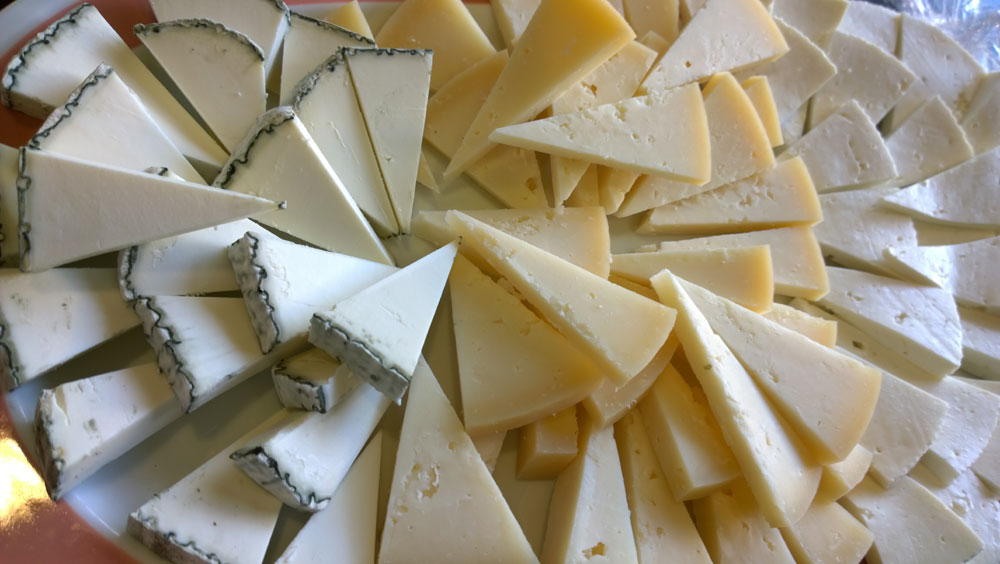The drive towards Avila from Madrid reveals a kind of living museum throughout the verdant and often dramatic topography that is the Castilla y Leon region of Spain. On a recent visit, where at every turn there’s another castle or ancient Roman road, I learn that some of the best sheep’s milk in Europe comes from the surrounding pastures. This is a region steeped in proud culinary traditions, artisan-made cheeses, wines and other edible gems. It’s the perfect place to slow down a few gears, explore and breathe deeply because, as any good cheese or wine maker will tell you, anything worth doing right, takes its own time. Here are a few of the region’s edible gems. [pagebreak]
Monte Enebro from Quesereias del Tietar
In Avila’s Tietar Valley, sisters Paloma and Maria Jesus helm the famous Queserias del Tietar. They make what’s considered one of the world’s finest goat’s milk cheeses: the Monte Enebro. This isn’t some secret, mysterious recipe,” says Maria Jesus in earnest, adding, “But it takes a lot of work to make this kind of cheese. We do almost everything by hand, the way it’s meant to be made and that takes time and patience.” It goes without saying that to make the loaf-like (or “mule’s leg” shaped) cheese covered with a light blue/grey rind courtesy of penicillium roqueforti spores also takes a lot of know-how. The end result is a silky, snow white cheese with savory, rich, almost lemony notes. It’s enough to make even devout non-goat’s milk cheese fans convert.
Zamorano from Vicente Pastor
Down the road in Zamora, we meet up with Felix Vicente Pastor, considered one of the most outstanding cheese makers in the country, at his farmhouse dairy. Production is very limited, given the family operation takes care of every detail, including sourcing its own milk from their herd of Churra sheep, a Castillian breed. Slow ripened (6-12 months) in high humidity cellars, his Zamorano offers a flavor that’s intense without being overwhelming. You’ll taste walnuts, grass, and a delicious buttery note in this piquant cheese; perfect alongside a crusty loaf of bread, some of the region’s ham, olives, tomatoes and a bottle of red, like the full bodied Toro DO from the nearby town of Toro. [pagebreak]
Verata ,”Torta” and Dehesa style cheeses from Hacienda Zorita
At the organic, beautifully manicured, slow food movement-following Hacienda Zorita, also in Zamora, you can enjoy a bird’s eye view of their cheese making process from a balcony overlooking the pristine facilities. If you call ahead, you can arrange for a cheese and wine tasting of their products, all made with the utmost care on their stunning property. Made by young cheese maker Gemma Cambero, who also leads the tutored tasting, you’ll be instructed to experience the cheese with all five senses. The 2012 World Cheese Award winning cured Dehesa has aromas of toasted oat, fruit, and lactic scent and tastes buttery and nutty.
Iberico, Ilbesa, Gran Cardenal, Garcia Filloy by Quesos Cerrato
At Restaurante Alcaravea in Madrid, where every dish sampled features a Spanish cheese (do try the huevos rotos– it’s fantastic!), we gorge on Castillian cheeses, some of which are made by a group of cheese makers that have formed a cooperative called Quesos Cerrato. These are Iberico cheeses, the closest thing to the much more globally recognized Manchego- but given a chance, these nutty nuanced, buttery beauties could garner as big a following. You can find most of these around Spain at the El Corte Ingles food halls (their national department store) in the refrigerated section. [pagebreak]
Various by Campoveja Fromagerie
If you find getting to farmhouses is a bit too arduous, stop by the terrific and tiny Campoveja Fromagerie in the heart of picturesque Valladolid. Here, Jesus Sanz sells some of the finest European and Spanish cheeses, including his own artisan crafted Campoveja cheeses. His semi-cured sheep’s milk cheese, which he says “maintains the flavor of our fields,” is a true expression of his passion for the land and Spanish cheeses. I ask Sanz for his personal Spanish favorites and he says they include: Monte Enebro (see above), Cañarejal from Zamora, and a goat and sheep’s milk blend from Cadiz called Payoyo (on the must-try list for next time!)


![Making Mealtime Matter with La Familia: Easy Sofrito [Video]](https://thelatinkitchen.com/wp-content/uploads/2015/10/sofrito-shutterstock__0-500x383.jpg)
![Easy Latin Smoothies: Goji Berry Smoothie [Video]](https://thelatinkitchen.com/wp-content/uploads/2015/12/goji_berry-shutterstock_-500x383.jpg)
















![Fun and Fast Recipes: Fiesta Cabbage Salad [Video]](https://thelatinkitchen.com/wp-content/uploads/2015/11/fiesta_cabbage_slaw-shutterstock_-500x383.jpg)









